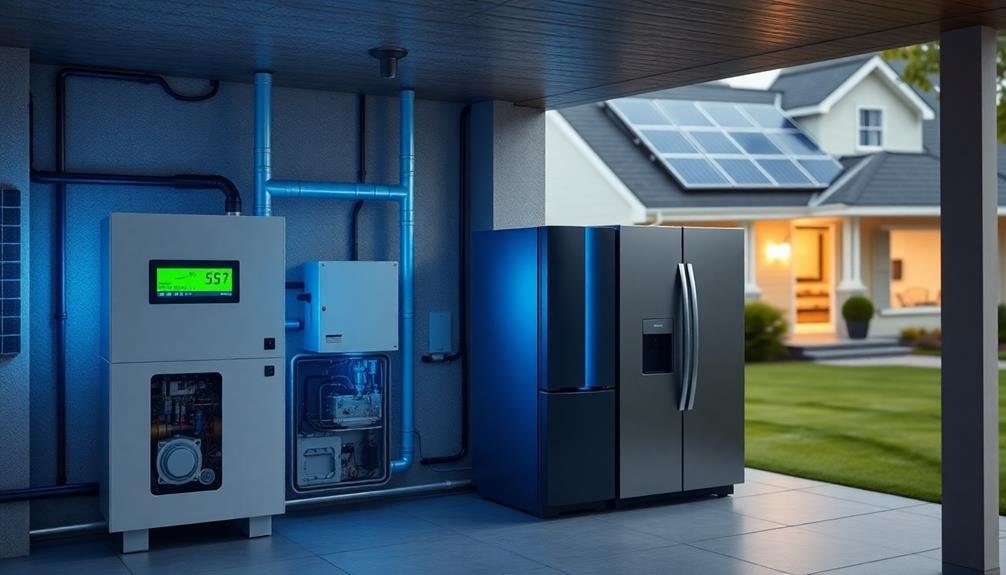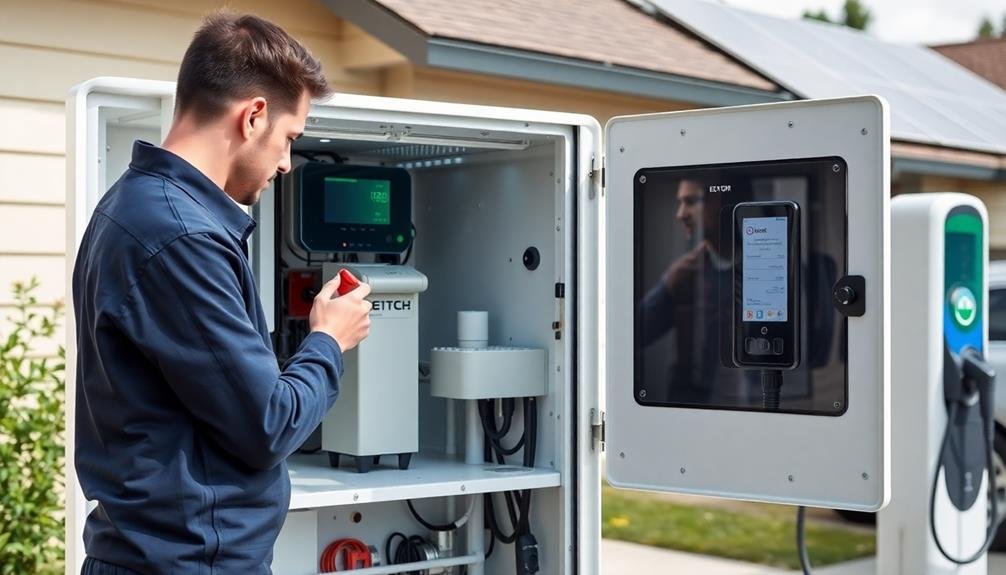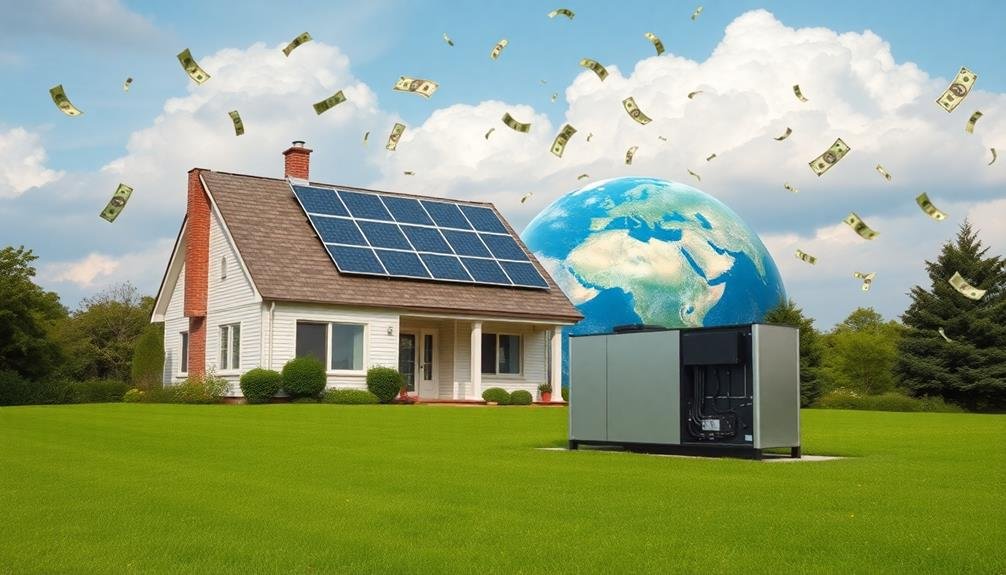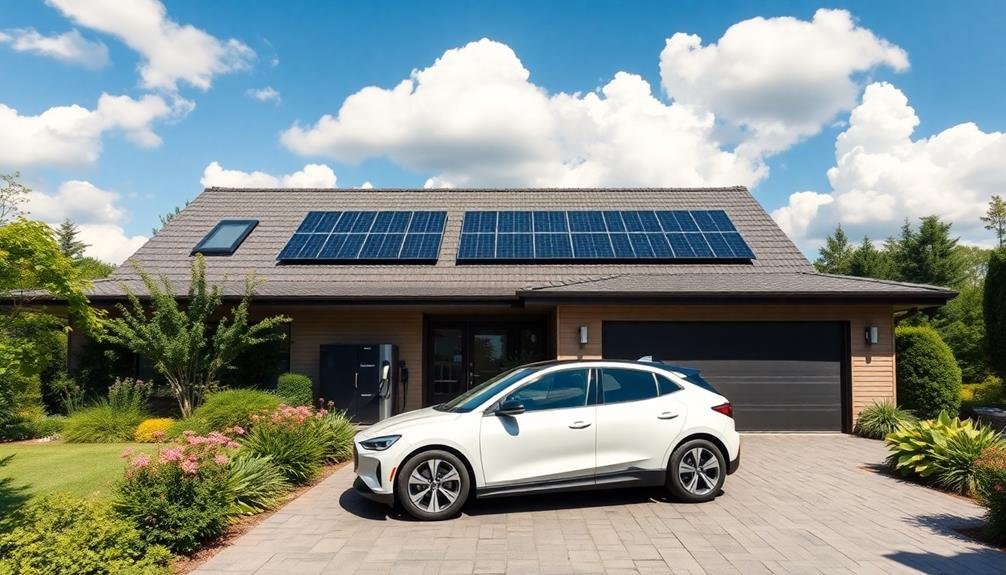You can considerably reduce your carbon footprint by adopting home fuel cell technology. These systems convert chemical energy into electricity, using hydrogen as fuel and producing only water vapor as a byproduct. Fuel cells emit far less CO2 than traditional power sources, with emissions comparable to solar and wind energy. They're also highly efficient, converting up to 60% of fuel into electricity. While initial costs may be high, government incentives can offset expenses. By installing a fuel cell system, you'll not only lower your environmental impact but also potentially save on energy bills. Dive deeper to uncover the full potential of this clean energy solution.
Understanding Home Fuel Cell Technology

The complexity of home fuel cell technology can be intimidating, but understanding its basics is essential for homeowners considering this eco-friendly option. Home fuel cells are devices that convert chemical energy into electrical energy through an electrochemical reaction. They typically use hydrogen as fuel, which reacts with oxygen from the air to produce electricity, heat, and water vapor.
You'll find two main types of fuel cells for residential use: proton exchange membrane (PEM) and solid oxide fuel cells (SOFC). PEM fuel cells operate at lower temperatures and are more suitable for smaller applications, while SOFCs work at higher temperatures and are better for larger-scale power generation.
These systems can be connected to your home's existing natural gas line, using a reformer to extract hydrogen from the gas. Alternatively, some models can use pure hydrogen supplied from storage tanks.
The electricity generated by the fuel cell can power your home, with excess energy potentially fed back into the grid. The heat produced as a byproduct can be used for space heating and hot water, increasing overall efficiency.
Environmental Benefits of Fuel Cells
Fuel cells offer significant environmental advantages for your home energy needs.
You'll benefit from lower greenhouse gas emissions and reduced air pollutants compared to traditional power sources.
Additionally, fuel cells provide efficient energy conversion, maximizing the use of fuel and minimizing waste.
Lower Greenhouse Gas Emissions
Environmental champions rejoice! You're about to discover how home fuel cells can greatly reduce your greenhouse gas emissions. By switching to this innovative technology, you'll be taking a powerful step towards a cleaner, greener future.
Fuel cells produce electricity through a chemical reaction between hydrogen and oxygen, resulting in water as the only byproduct. This process emits far fewer greenhouse gases compared to traditional energy sources. Here's a comparison of greenhouse gas emissions from various energy sources:
| Energy Source | CO2 Emissions (lbs/MWh) |
|---|---|
| Coal | 2,000 |
| Natural Gas | 1,100 |
| Solar | 50 |
| Wind | 25 |
| Fuel Cell | 0-50 |
As you can see, fuel cells emit greatly less CO2 than fossil fuels and are on par with renewable energy sources. By installing a home fuel cell system, you'll reduce your carbon footprint by up to 50% compared to using grid electricity. This reduction in greenhouse gas emissions helps combat climate change and improves air quality in your local community. You'll be doing your part to create a more sustainable future for generations to come.
Reduced Air Pollutants
Beyond reducing greenhouse gas emissions, home fuel cells offer another notable environmental advantage: cleaner air.
When you switch to a fuel cell system, you're notably cutting down on air pollutants that traditional energy sources typically emit. Fuel cells produce electricity through a chemical reaction, not combustion, which means they generate far fewer harmful byproducts.
You'll notice a marked reduction in pollutants such as:
- Nitrogen oxides (NOx)
- Sulfur dioxide (SO2)
- Particulate matter
These reductions contribute to improved air quality in your immediate surroundings and the broader community. By choosing fuel cells, you're not only helping to combat climate change but also directly impacting local air quality. This can lead to better respiratory health for you, your family, and your neighbors.
Moreover, fuel cells don't produce the smog-forming pollutants associated with conventional power plants. As more homes adopt this technology, you'll be part of a collective effort to create cleaner, healthier urban environments.
The cumulative effect of widespread fuel cell adoption could notably reduce the occurrence of smog and acid rain in densely populated areas, leading to clearer skies and healthier ecosystems.
Efficient Energy Conversion
When you're considering the environmental benefits of home fuel cells, you can't overlook their impressive energy conversion efficiency. Fuel cells convert chemical energy directly into electrical energy, bypassing the inefficient combustion process used in traditional power generation. This direct conversion results in markedly higher efficiency rates, typically ranging from 40% to 60%, compared to conventional power plants that often operate at 30-40% efficiency.
You'll find that fuel cells can utilize various fuel sources, each with its own efficiency advantages:
| Fuel Type | Efficiency | CO2 Emissions | Availability |
|---|---|---|---|
| Hydrogen | 60-80% | Zero | Limited |
| Natural Gas | 45-60% | Low | Widespread |
| Biogas | 40-50% | Neutral | Increasing |
| Methanol | 35-60% | Moderate | Growing |
Comparing Fuel Cells to Traditional Energy

As we explore alternatives to traditional energy sources, fuel cells emerge as a promising option for reducing your carbon footprint at home.
When comparing fuel cells to traditional energy, you'll find several key advantages. Fuel cells offer higher efficiency, converting up to 60% of fuel into electricity, compared to about 35% for conventional power plants. They also produce fewer emissions, with water vapor being the primary byproduct.
Unlike traditional energy sources, fuel cells don't rely on combustion, which means they're quieter and have fewer moving parts. This translates to lower maintenance costs and increased reliability.
You'll also benefit from decentralized power generation, reducing your dependence on the grid and potential outages.
Here are some notable differences between fuel cells and traditional energy:
- Fuel cells can use a variety of fuels, including hydrogen, natural gas, and biogas
- They operate continuously as long as fuel is supplied, unlike intermittent renewable sources
- Fuel cells have a smaller physical footprint than many traditional power generation methods
While initial costs may be higher, the long-term benefits of fuel cells make them an attractive option for environmentally conscious homeowners looking to reduce their carbon footprint.
Installation Process for Home Systems
When considering a home fuel cell system, you'll need to decide between professional installation and a DIY approach.
Professional installation guarantees proper setup and compliance with local regulations, while a DIY option might save costs but requires extensive knowledge and skills.
Regardless of your choice, you'll likely need to modify your home's electrical system and possibly your gas lines to accommodate the fuel cell unit.
Professional vs. DIY Installation
Homeowners face a crucial decision when it comes to installing fuel cell systems: professional installation or DIY.
Professional installation offers expertise, warranty coverage, and peace of mind. Certified technicians guarantee proper setup, compliance with local codes, and peak system performance. However, it's often more expensive and may have longer wait times.
DIY installation can be cost-effective and gives you control over the process. It's suitable for those with technical skills and knowledge of electrical systems. But it comes with risks, including potential damage to equipment, voided warranties, and safety hazards.
Before deciding, consider these factors:
- Your technical expertise and comfort level with complex systems
- Local regulations and permit requirements
- The complexity of your specific fuel cell system
If you're confident in your abilities and local laws allow it, DIY installation can be rewarding.
However, for most homeowners, professional installation is the safer, more reliable choice. It guarantees your fuel cell system operates efficiently and safely, maximizing its capacity to reduce your carbon footprint.
Whichever route you choose, thorough research and careful planning are essential for a successful installation.
Required Home Modifications
Installing a home fuel cell system often requires significant modifications to your existing infrastructure.
You'll need to prepare your home for the integration of this technology, starting with a thorough assessment of your current electrical system. Most homes will require an upgrade to their electrical panel to accommodate the fuel cell's output and guarantee proper load distribution.
Next, you'll need to create a dedicated space for the fuel cell unit. This typically involves designating an area in your basement, garage, or utility room that's well-ventilated and easily accessible for maintenance.
You'll also need to install proper ventilation systems to manage heat and exhaust from the fuel cell.
Plumbing modifications are necessary to connect the fuel cell to your home's natural gas supply or to install a separate gas line if needed.
You'll also need to set up a water connection for the fuel cell's cooling system.
Additionally, you may need to make changes to your home's heating and cooling systems to integrate with the fuel cell's heat recovery capabilities.
Maintenance and Longevity Considerations

Reliability is a key factor when considering home fuel cells for long-term use. These systems are designed to operate continuously for extended periods, often with minimal intervention. However, you'll need to be aware of certain maintenance requirements to guarantee peak performance and longevity.
Regular inspections and servicing by qualified technicians are essential to maintain your fuel cell's efficiency. You'll typically need to schedule annual check-ups to assess the system's components and replace any worn parts. Additionally, you should monitor the fuel cell's performance regularly, looking for any signs of decreased output or unusual behavior.
Consider these key maintenance aspects:
- Water management: Guarantee proper water quality and levels
- Air filtration: Replace air filters periodically to prevent contaminants
- Fuel supply: Monitor and maintain consistent fuel quality
The lifespan of a home fuel cell system can vary depending on usage and maintenance. With proper care, many systems can operate efficiently for 10 to 20 years.
As technology advances, you may find that newer, more efficient models become available during your system's lifetime. Keep this in mind when planning for long-term energy solutions in your home.
Cost Analysis of Fuel Cell Adoption
When it comes to adopting home fuel cells, you'll need to carefully weigh the costs against the potential benefits. The initial investment for a residential fuel cell system can be substantial, ranging from $15,000 to $30,000 or more, depending on the size and complexity of the installation.
However, you'll likely see significant savings on your energy bills over time. To calculate the payback period, evaluate your current energy costs and compare them to the projected savings from fuel cell power.
Factor in potential government incentives, tax credits, and rebates that can offset the upfront costs. Don't forget to account for maintenance expenses and the lifespan of the system, typically 10-15 years.
You'll also need to assess the cost of fuel, usually natural gas or hydrogen, which will impact your ongoing expenses. While fuel cells are generally more efficient than traditional power sources, fuel prices can fluctuate.
Analyze long-term energy price projections in your analysis. Lastly, weigh the environmental benefits against the financial investment. Reducing your carbon footprint may have intangible value that's difficult to quantify but important to evaluate in your decision-making process.
Government Incentives for Clean Energy

To encourage the adoption of clean energy technologies like home fuel cells, governments around the world offer various incentives. These programs aim to offset the initial costs and make clean energy solutions more accessible to homeowners.
In the United States, you'll find both federal and state-level incentives that can greatly reduce your investment in home fuel cell systems. The federal government offers a tax credit of up to 30% of the cost of qualified fuel cell property, with a maximum credit of $3,000 per kilowatt of capacity.
Many states provide additional incentives, such as rebates, grants, or low-interest loans. To maximize your benefits, you should:
- Research your state's specific incentives
- Combine federal and state programs when possible
- Stay informed about new or changing policies
It's important to note that these incentives can change over time, so it's vital to check the most up-to-date information before making a decision.
Future Developments in Fuel Cells
The horizon of fuel cell technology is rapidly expanding, promising exciting advancements in the coming years. You'll likely see improvements in efficiency, durability, and cost-effectiveness of home fuel cells. Researchers are working on new materials for electrodes and membranes that could greatly boost performance and longevity.
You might soon encounter fuel cells that can operate at lower temperatures, making them safer and more versatile for residential use.
Another area of development is in fuel flexibility. Future fuel cells may be able to run on a variety of fuels, including hydrogen, natural gas, and even renewable biogas. This versatility will make it easier for you to adopt fuel cell technology regardless of your local energy infrastructure.
You should also keep an eye on miniaturization efforts. Compact fuel cells could power individual appliances or be integrated into smart home systems.
Additionally, advancements in energy storage technology will complement fuel cells, allowing you to store excess energy for later use. As these developments unfold, you'll find that home fuel cells become an increasingly attractive option for reducing your carbon footprint and achieving energy independence.
Frequently Asked Questions
Can Home Fuel Cells Work During Power Outages?
Yes, home fuel cells can work during power outages. They'll provide you with a reliable source of electricity when the grid fails. You'll have continuous power as long as you maintain a fuel supply for your fuel cell system.
Are There Any Safety Concerns With Having Fuel Cells at Home?
You should be aware of some safety concerns with home fuel cells. They use flammable fuels, so proper installation and maintenance are essential. There's also a risk of carbon monoxide leaks, so you'll need CO detectors installed.
How Noisy Are Home Fuel Cell Systems?
You'll be pleased to know that home fuel cell systems are typically very quiet. They don't have many moving parts, so they operate with minimal noise. You'll hardly notice them running in your home.
Can Fuel Cells Be Used in Apartments or Only Single-Family Homes?
You can use fuel cells in apartments, not just single-family homes. However, you'll need to check your building's regulations and get landlord approval. Space requirements and ventilation needs may limit options in some apartment settings.
Is It Possible to Go Completely Off-Grid With Home Fuel Cells?
You can go completely off-grid with home fuel cells, but it's challenging. You'll need a robust system, backup power, and ample fuel supply. It's more feasible in rural areas where you've got space for equipment and storage.
In Summary
You've now got a clear picture of how home fuel cells can slash your carbon footprint. They're a promising alternative to traditional energy sources, offering environmental benefits and potential cost savings. While the initial investment may be significant, government incentives can help offset expenses. As technology advances, fuel cells will likely become more efficient and affordable. Consider making the switch to fuel cells and lead the charge towards a greener future.





Leave a Reply